Microcontrollers (MCUs) are the backbone of modern electronics, providing the processing power and control. From simple projects to industrial control systems, MCUs are integral in making electronic devices smart and responsive. This article delves into various types of popular microcontrollers, detailing their features, specifications, and common uses.
In this article:
MCU 1: Arduino Uno MCU 2: Arduino Nanos MCU 3: ESP32 MCU 4: ESP8266 MCU 5: STM32F3 Series MCU 6: STM32F0 Series Comparison of the Popular MCUs One-Stop PCBA Manufacturer for IoT SystemsMCU 1: Arduino Uno
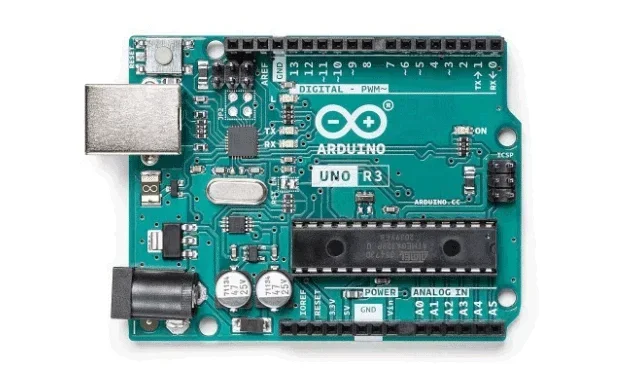
Technical Specifications
- Chip used: ATmega328P
- Memory size: 32 KB
- RAM size: 2 KB
- Flash memory: 32 KB
- Clock speed: 16 MHz
- Power consumption: Low
- Voltage requirement: 5V
- Current requirement: 50 mA
- Low power current requirement: 1.8 mA
- High power current requirement: 40 mA
Communication Protocols
- UART: Universal asynchronous receiver/transmitter for serial communication.
- I2C: Inter-integrated circuit for communication with multiple peripherals.
- SPI: Serial peripheral interface for high-speed synchronous data transfer.
Common Uses and Applications
The Arduino Uno is widely used in educational projects, DIY electronics, and prototyping. Its simplicity and ease of use make it ideal for beginners and hobbyists. Common applications include robotics, home automation, and interactive art installations.
Benefits:
- User-friendly: Ideal for beginners with extensive documentation and community support.
- Shield compatibility: Supports a wide range of shields for easy expansion.
- Educational value: Widely used in educational settings for teaching electronics and programming.
- Robust community: A large community provides numerous tutorials, projects, and troubleshooting help.
MCU 2: Arduino Nano
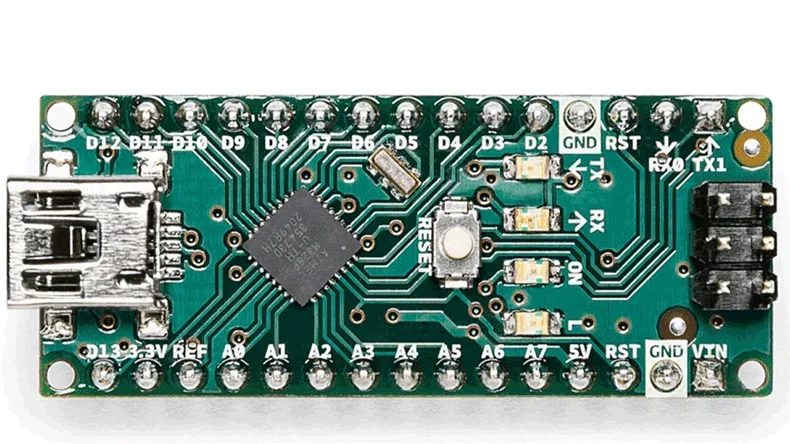
Technical Specifications
- Chip used: ATmega328P
- Memory size: 32 KB
- RAM size: 2 KB
- Flash memory: 32 KB
- Clock speed: 16 MHz
- Power consumption: Low
- Voltage requirement: 5V
- Current requirement: 50 mA
- Low power current requirement: 1.8 mA
- High power current requirement: 40 mA
Communication Protocols
- UART: Universal asynchronous receiver/transmitter for serial communication.
- I2C: Inter-integrated circuit for communication with multiple peripherals.
- SPI: Serial peripheral interface for high-speed synchronous data transfer.
Common Uses and Applications
The Arduino Nano is perfect for compact projects where space is a constraint. It is commonly used in wearable electronics, small robotics, and portable devices. Its small size and full functionality make it a favorite for projects requiring minimal space.
Benefits:
- Compact size: Small form factor makes it ideal for projects with space constraints.
- Breadboard friendly: Fits easily on a breadboard for prototyping.
- Low power consumption: Lower power consumption compared to the Uno, making it suitable for battery-operated projects.
- Cost-effective: Affordable alternative to the Arduino Uno with similar capabilities.
MCU 3: ESP32
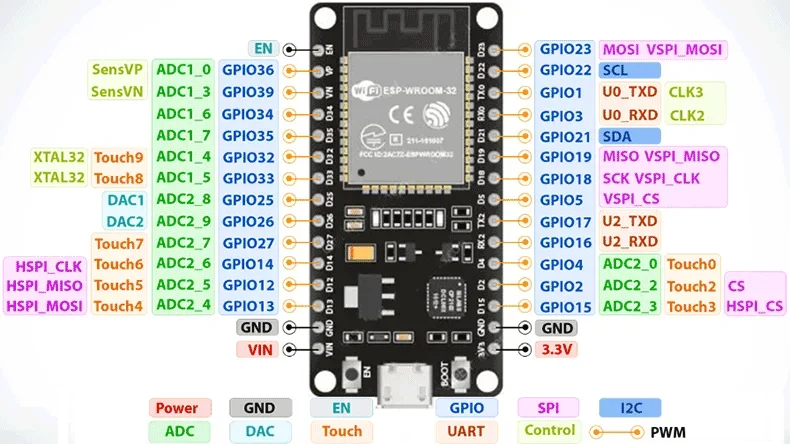
Technical Specifications
- Chip used: ATmega328P
- Memory size: 32 KB
- RAM size: 2 KB
- Flash memory: 32 KB
- Clock speed: 16 MHz
- Power consumption: Low
- Voltage requirement: 5V
- Current requirement: 50 mA
- Low power current requirement: 1.8 mA
- High power current requirement: 40 mA
Communication Protocols
- UART: Universal asynchronous receiver/transmitter for serial communication.
- I2C: Inter-integrated circuit for communication with multiple peripherals.
- SPI: Serial peripheral interface for high-speed synchronous data transfer.
Common Uses and Applications
The Arduino Nano is perfect for compact projects where space is a constraint. It is commonly used in wearable electronics, small robotics, and portable devices. Its small size and full functionality make it a favorite for projects requiring minimal space.
Benefits:
- Compact size: Small form factor makes it ideal for projects with space constraints.
- Breadboard friendly: Fits easily on a breadboard for prototyping.
- Low power consumption: Lower power consumption compared to the Uno, making it suitable for battery-operated projects.
- Cost-effective: Affordable alternative to the Arduino Uno with similar capabilities.
MCU 4: ESP8266
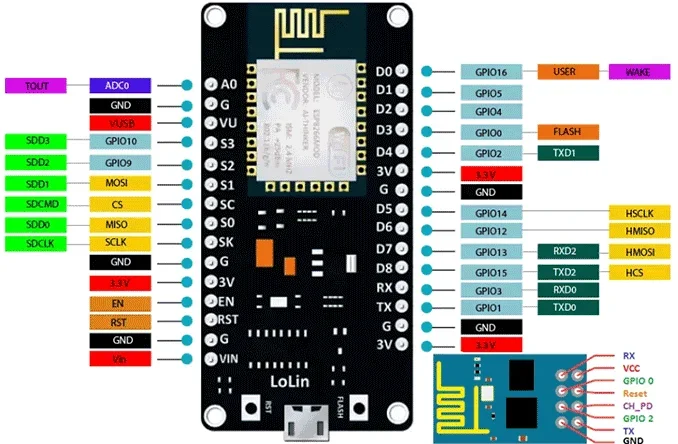
Technical Specifications
- Chip used: Tensilica L106
- Memory size: 64 KB
- Flash memory: 1 MB
- Clock speed: 80 MHz
- Power consumption: Low
- Voltage requirement: 3.3V
- Current requirement: 70 mA
- Low power current requirement: 10 µA
- High power current requirement: 170 mA
Communication Protocols
- UART: Universal asynchronous receiver/transmitter for serial communication.
- UART: Universal asynchronous receiver/transmitter for serial communication.
- I2C: Inter-integrated circuit for communication with multiple peripherals.
- SPI: Serial peripheral interface for high-speed synchronous data transfer.
- Wi-Fi: For wireless connectivity.
Benefits:
- Cost-effective: Very affordable, making it suitable for budget-conscious projects.
- Wi-Fi capabilities: Built-in Wi-Fi for easy internet connectivity.
- Compact size: Small footprint for space-constrained projects.
- Extensive community support: Large user base with abundant resources and project examples.
MCU 5: STM32F3 Series
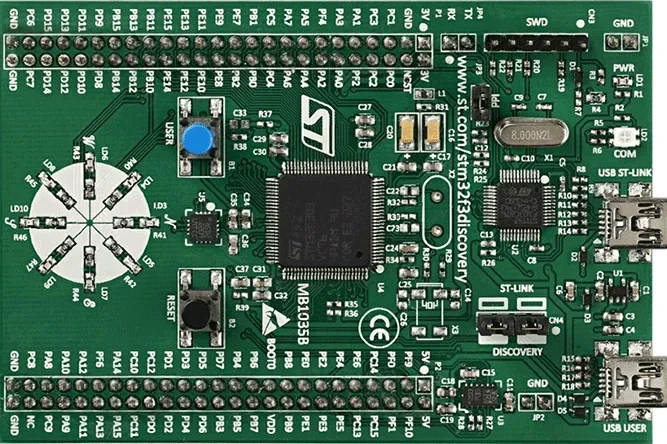
Technical Specifications
- Chip used: ARM Cortex-M4
- Memory size: Up to 40 KB
- Flash memory: Up to 256 KB
- Clock speed: 72 MHz
- Power consumption: Medium
- Voltage requirement: 3.3V
- Current requirement: 30 mA
- Low power current requirement: 2 µA
- High power current requirement: 150 mA
Communication Protocols
- UART: Universal asynchronous receiver/transmitter for serial communication.
- I2C: Inter-integrated circuit for communication with multiple peripherals.
- SPI: Serial peripheral interface for high-speed synchronous data transfer.
- CAN: Controller area network for robust automotive and industrial communication.
Benefits:
- High performance: ARM Cortex-M4 core with FPU for high-speed processing.
- Versatile peripherals: Wide range of peripherals, including ADCs, DACs, and communication interfaces.
- Industrial applications: Suitable for industrial applications with robust performance and CAN protocol support.
- Advanced features: Enhanced features like DSP instructions and floating-point unit for complex computations.
MCU 6: STM32F0 Series

Technical Specifications
- Chip used: ARM Cortex-M0 core
- Memory size: 16 KB to 256 KB flash memory
- RAM size: 4 KB to 32 KB
- Flash memory: 16 KB to 256 KB
- Clock speed: Up to 48 MHz
- Power consumption: Typically 5 mA
- Voltage requirement: 2.0V to 3.6V
- Current requirement: Typically 5 mA
- Low power current requirement: Down to 1 µA in low-power mode
- High power current requirement: Up to 20 mA in high power mode
Communication Protocols
- UART: Universal asynchronous receiver/transmitter for serial communication.
- I2C: Inter-integrated circuit for communication with multiple peripherals.
- SPI: Serial peripheral interface for high-speed synchronous data transfer.
- CAN: Controller area network for robust automotive and industrial communication.
- USB: Universal serial bus for connectivity with various devices.
Common Uses and Applications
The STM32F0 series is perfect for cost-sensitive and low-power applications. It is commonly used in consumer electronics, energy-efficient systems, and simple control applications. Its affordability and low power consumption make it ideal for battery-operated devices.
Benefits:
- Cost-effective: Affordable option for a wide range of applications.
- Low power consumption: Excellent for battery-operated devices with low power modes.
- Compact and efficient: Good performance within a compact size, suitable for embedded systems.
- Wide voltage range: Operates within a 2.0V to 3.6V range, providing flexibility for different power sources.
Comparison of the Popular MCUs
Each MCU offers distinct advantages tailored to different project needs. Below are comparisons among them so you can choose the right one.
Memory and Storage Comparison
|
Feature
|
Arduino Uno
|
Arduino Nano
|
ESP32
|
ESP8266
|
STM32F3 Series
|
STM32F0 Series
|
|
Chip used
|
ATmega328P
|
ATmega328P
|
Tensilica LX6
|
Tensilica L106
|
ARM Cortex-M4
|
ARM Cortex-M0
|
|
Memory size (RAM)
|
2 KB
|
2 KB
|
520 KB
|
64 KB
|
Up to 80 KB
|
4-32 KB
|
|
Flash memory
|
32 KB
|
32 KB
|
4-16 MB
|
1 MB
|
Up to 256 KB
|
16-256 KB
|
|
Clock speed
|
16 MHz
|
16 MHz
|
240 MHz
|
80 MHz
|
72 MHz
|
48 MHz
|
|
Power consumption (Active)
|
Low
|
Low
|
Medium
|
Low
|
Medium
|
Low
|
|
Voltage requirement
|
5V
|
5V
|
3.3V
|
3.3V
|
3.3V
|
2.0V-3.6V
|
|
Current requirement
|
50 mA
|
50 mA
|
500 mA
|
70 mA
|
30 mA
|
5 mA
|
The ESP32 stands out in terms of memory and storage capabilities, featuring up to 520 KB of RAM and 16 MB of flash memory. This makes it an excellent choice for complex applications requiring substantial memory, such as advanced IoT devices, real-time processing tasks, and extensive data storage needs. The high memory capacity allows developers to implement more sophisticated algorithms and store larger datasets directly on the MCU.
The STM32F3 series offers a balanced memory configuration with up to 512 KB of flash memory and up to 80 KB of RAM. This balance makes it suitable for applications that require moderate computational power and memory, such as industrial control systems, motor control applications, and advanced embedded systems with multiple sensor integrations.
For basic projects, the Arduino Uno and Arduino Nano provide sufficient memory with 32 KB of flash memory and 2 KB of RAM. These MCUs are ideal for simple automation tasks, basic sensor interfacing, and educational projects where high memory capacity is not a critical requirement. Their straightforward architecture and ease of use make them perfect for beginners and hobbyists.
Power Efficiency Comparison
|
Feature
|
Arduino Uno
|
Arduino Nano
|
ESP32
|
ESP8266
|
STM32F3 Series
|
STM32F0 Series
|
|
Low power current
|
1.8 mA
|
1.8 mA
|
10 µA
|
10 µA
|
2 µA
|
1 µA
|
|
High power current
|
40 mA
|
40 mA
|
500 mA
|
170 mA
|
150 mA
|
20 mA
|
|
Power consumption (Active)
|
Low
|
Low
|
Medium
|
Low
|
Medium
|
Very low
|
|
Voltage requirement
|
5V
|
5V
|
3.3V
|
3.3V
|
3.3V
|
2.0V-3.6V
|
The STM32F0 series excels in power efficiency, with a typical power consumption of around 5 mA and the ability to drop down to 1 µA in low-power mode. This makes it ideal for battery-operated devices and applications where energy consumption is a critical concern, such as portable medical devices, remote sensors, and low-power wireless communication systems. The ability to operate efficiently at low power ensures longer battery life and reduced operational costs.
The ESP32 and ESP8266 also offer low power modes, with the ESP32 consuming as little as 10 µA in deep sleep mode and the ESP8266 consuming a similar amount. However, their active power consumption is higher due to their advanced features and connectivity options. The ESP32, for example, consumes between 160-260 mA in active mode, making it suitable for IoT applications where devices can remain in sleep mode for extended periods and only wake up occasionally for processing.
Performance Comparison
|
Feature
|
Arduino Uno
|
Arduino Nano
|
ESP32
|
ESP8266
|
STM32F3 Series
|
STM32F0 Series
|
|
Clock speed
|
16 MHz
|
16 MHz
|
240 MHz
|
80 MHz
|
72 MHz
|
Up to 48 MHz
|
|
Memory size (RAM)
|
2 KB
|
2 KB
|
520 KB
|
64 KB
|
Up to 40 KB
|
4-32 KB
|
|
Flash memory
|
32 KB
|
32 KB
|
4-16 MB
|
1 MB
|
Up to 256 KB
|
16-256 KB
|
|
Communication protocols
|
UART, I2C, SPI
|
UART, I2C, SPI
|
UART, I2C, SPI, Wi-Fi, Bluetooth
|
UART, I2C, SPI, Wi-Fi
|
UART, I2C, SPI, CAN
|
UART, I2C, SPI, CAN, USB
|
The ESP32 leads in performance with a clock speed of up to 240 MHz, making it suitable for demanding tasks such as real-time audio processing, complex IoT applications, and edge computing. Its dual-core processor and high clock speed provide the computational power needed for sophisticated algorithms and high-speed data processing.
The STM32F3 series follows with a clock speed of up to 72 MHz, providing high performance for industrial control systems, motor control applications, and advanced embedded systems. Its ARM Cortex-M4 core with a floating-point unit (FPU) enhances its capability for numerical computations and signal processing tasks.
The Arduino Uno and Nano, with a clock speed of 16 MHz, are adequate for less demanding tasks. They are well-suited for basic automation, simple data logging, and educational projects where high processing power is not necessary. The STM32F0 series, while slower with a clock speed of up to 48 MHz, is efficient for simpler applications like basic control systems, small appliances, and basic sensor networks.
Cost Comparison
The ESP8266 is the most affordable MCU among those compared, making it ideal for budget-conscious projects. Its low cost, combined with built-in Wi-Fi capabilities, makes it a popular choice for basic IoT devices, smart home gadgets, and DIY electronics projects.
The Arduino Uno and Nano are moderately priced, offering a good balance between cost and functionality. They are great for beginners and educational purposes, providing an accessible entry point into electronics and programming with extensive community support and resources.
The ESP32, with its advanced features and connectivity options, comes at a higher cost but offers significant value for complex projects requiring high performance and extensive memory. It is suitable for advanced IoT systems, real-time data processing applications, and high-performance embedded projects.
The STM32 series varies in price, with the STM32F0 series being more affordable and the STM32F3 series offering more advanced features at a higher price. The F0 series is cost-effective for simpler applications, while the F3 series is suitable for industrial and high-performance applications that justify the higher cost with enhanced capabilities and reliability.
Flash Memory
Flash memory is crucial for storing firmware and applications. The ESP32, with 4 MB to 16 MB of flash memory, allows for larger and more complex programs compared to the Arduino Uno's 32 KB. This large flash memory capacity enables the ESP32 to handle applications that require extensive code, multiple libraries, and large datasets, making it suitable for advanced IoT devices and applications with significant storage needs.
Clock Speed
Clock speed directly affects the processing power of an MCU. The ESP32, with a clock speed of up to 240 MHz, significantly outperforms the Arduino Uno's 16 MHz. This high clock speed allows the ESP32 to execute more instructions per second, making it ideal for real-time applications, high-speed data processing, and tasks that require rapid response times. In contrast, the Arduino Uno's lower clock speed is sufficient for simpler tasks and educational projects where high performance is not a critical requirement.
Power Consumption
Different applications have varying power needs. The ESP8266, with its 10 µA low power current requirement, is ideal for low-power projects where devices need to remain in sleep mode for extended periods, such as remote sensors and battery-operated IoT devices. This low power consumption ensures longer battery life and efficient operation in energy-constrained environments.
Current and Voltage Requirements
Voltage and current requirements vary among MCUs. The STM32 series, with its flexible voltage requirements of 1.8V to 3.6V, caters to a broad range of applications. This flexibility allows the STM32 MCUs to be used in various environments and with different power sources, making them suitable for industrial applications, consumer electronics, and battery-operated devices.
Now, you've learned comprehensive specs of the top 6 popular MCUs and comparisons among them from different aspects. Understanding these detailed specifications and benefits helps in selecting the right MCU for specific project needs, ensuring optimal performance, cost-efficiency, and power management.
To use any of these popular Microcontrollers in applications, you will need to design your PCB project and work with a PCBA manufacturer to bring it into reality.
One-Stop PCBA Manufacturer for IoT Systems
PCBONLINE is a PCBA manufacturer specializing in IoT systems and devices from prototype to massive production. You can work with PCBONLINE for turnkey IoT PCBA manufacturing, including PCB fabrication, components sourcing (including MCUs), PCB assembly, PCBA value-added, and box-build assembly.

Founded in 1999, PCBONLINE has two large advanced PCB manufacturing bases, one turnkey PCB assembly factory, stable supply chains, and an R&D team.
PCBONLINE has rich experience and R&D capabilities for IoT systems, especially those based on and controlled by MCUs.
PCBONLINE has strategic cooperation with popular MCU companies, including Eepressif, Neoway, Quactel, Fibocom, and Simcom (the last four are famous for wireless communication devices).
All components, including the MCUs, are original and traceable, purchased directly from original component factories or first-class suppliers.
PCBONLINE can select alternate components to replace the expensive ones and optimize your design to reduce your project's costs.
High-quality IoT PCBA manufacturing certified with ISO9001:2015, ISO14001:2015, IATF16949:2016, RoHS, REACH, UL, and IPC-A-610 Class 2/3.
Free DFM (design for manufacturing) to ensure the success of your project. Free PCBA functional testing and program burn-in, and refund prototype/sample and R&D fees when your project goes to the massive production stage.
Once you send your Gerber and BOM to us, we will check your documents and offer one-on-one engineering support. To get a quote for your IoT project manufacturing, including the purchasing of the popular MCUs, please email info@pcbonline.com.
Last Quick FAQs about the Popular MCUs
1. What is the main difference between the ESP32 and ESP8266?
The ESP32 offers more processing power, memory, and built-in Bluetooth compared to the ESP8266, which makes it suitable for more complex and demanding applications.
2. Can I use Arduino Nano instead of Arduino Uno for my project?
Yes, the Arduino Nano can be used as a compact alternative to the Arduino Uno, with similar functionality and pin compatibility.
3. How do I choose between ESP32 and ESP8266?
Choose ESP32 for more processing power and integrated Bluetooth. Opt for ESP8266 for simpler, cost-effective IoT projects.
4. Which microcontroller is best for low-power applications?
The STM32F0 series is highly recommended for low-power applications due to its efficient power consumption.
5. What makes the STM32F3 series suitable for industrial applications?
The STM32F3 series offers advanced features, high performance, and a wide range of peripherals, making it ideal for industrial and complex applications.
6. Why choose Arduino for educational projects?
Arduino boards, such as the Uno and Nano, are user-friendly, well-documented, and supported by a large community, making them perfect for educational and beginner projects.
Conclusion
Choosing the right microcontroller depends on the specific needs of your project. The Arduino Uno and Nano are best for beginners and educational purposes due to their ease of use and community support. The ESP32 excels in high-performance, complex IoT applications with its advanced features and connectivity. The ESP8266 is a cost-effective choice for budget projects with low-power requirements. The STM32F3 series offers a balance of performance and memory for industrial control systems, while the STM32F0 series excels in power efficiency, making it perfect for battery-operated devices and energy-critical applications. If you have questions about choosing which MCU for your project and need PCBA manufacturing, work with the one-stop IoT PCBA manufacturer PCBONLINE.
PCB assembly at PCBONLINE.pdf




